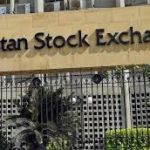 During this past week ended 9th August 2019, the benchmark index of Pakistan Stock Exchange (PSX) fell more than 7.1%WoW to close at 29,429 points. It breached the psychological barrier of 30,000 after five years. This un-ceremonial fall was caused by mounting macro risks and growing unrest in Indian Occupied Kashmir. Key news flows during the week included: 1) the Government of Pakistan (GoP) minimized furnace oil and coal based power generation to facilitate maximum intake of RLNG to avoid US$30 million penalty under Take or Pay mechanism and reduce the volume of demurrages, 2) FBR announced not to take any adverse action against traders on the condition of provision of CNIC numbers till 30th September this year, 3) the ECC of the Cabinet on Thursday approved mechanism for payment of subsidy on account of lower gas price of US$6.5/mmbtu to the export industry and ordered to have a proper definition of export oriented sector to avoid misuse of public funds, 4) the National Security Committee on Wednesday decided to contain diplomatic ties with India and suspend bilateral trade in response to New Delhi’s move to annex occupied Kashmir and 5) National Accountability Bureau (NAB) on Wednesday arrested former Finance Minister, Miftah Ismail and former Managing Director of Pakistan State Oil Company (PSO), Sheikh Imran-ul-Haq, in LNG corruption reference.
During this past week ended 9th August 2019, the benchmark index of Pakistan Stock Exchange (PSX) fell more than 7.1%WoW to close at 29,429 points. It breached the psychological barrier of 30,000 after five years. This un-ceremonial fall was caused by mounting macro risks and growing unrest in Indian Occupied Kashmir. Key news flows during the week included: 1) the Government of Pakistan (GoP) minimized furnace oil and coal based power generation to facilitate maximum intake of RLNG to avoid US$30 million penalty under Take or Pay mechanism and reduce the volume of demurrages, 2) FBR announced not to take any adverse action against traders on the condition of provision of CNIC numbers till 30th September this year, 3) the ECC of the Cabinet on Thursday approved mechanism for payment of subsidy on account of lower gas price of US$6.5/mmbtu to the export industry and ordered to have a proper definition of export oriented sector to avoid misuse of public funds, 4) the National Security Committee on Wednesday decided to contain diplomatic ties with India and suspend bilateral trade in response to New Delhi’s move to annex occupied Kashmir and 5) National Accountability Bureau (NAB) on Wednesday arrested former Finance Minister, Miftah Ismail and former Managing Director of Pakistan State Oil Company (PSO), Sheikh Imran-ul-Haq, in LNG corruption reference.
Average daily traded volume during the week declined to 57.85 million shares. Volume leaders included: MLCF, KEL, TRG, UNITY and ISL. Stocks leading the performance board during the week included: DGKC, MLCF, EFOODS and NCL, on the flipside, stocks heading lower included: UBL, APL, HASCOL, HMB and INDU. A rally would hinge on likely emergence from: 1) conclusion of the current cycle of monetary tightening seen in September 2019 Monetary Policy, expectations can be seen crystallizing on 21st August 2019 PIB auction participation, 2) successful completion of IMF’s second quarterly review, expected during November and FATF consultations, scheduled in October this year and 3) external space emerging from global monetary tightening, softening US$ and weak prices of energy commodities.